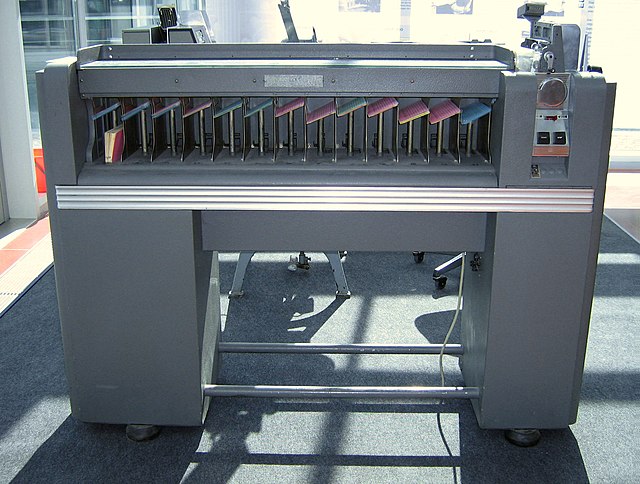A keypunch is a device for precisely punching holes into stiff paper cards at specific locations as determined by keys struck by a human operator. Other devices included here for that same function include the gang punch, the pantograph punch, and the stamp. The term was also used for similar machines used by humans to transcribe data onto punched tape media.
IBM 026 Keypunch
Keypunch operators at work at the U.S. Social Security Administration in the 1940s
Operators compiling hydrographic data for navigation charts on punch cards using the IBM Type 016 Electric Duplicating Key Punch, New Orleans, 1938
Hollerith's Keyboard (pantograph) Punch. This photo is staged; the keyboard layout is for the Farm card (leftmost column is labeled "Kind of Farm") of an Agricultural Census while the paper under the punch shows the layout of the 1890 Population Census card (the actual 1890 census cards had no printing).
Starting at the end of the nineteenth century, well before the advent of electronic computers, data processing was performed using electromechanical machines collectively referred to as unit record equipment, electric accounting machines (EAM) or tabulating machines.
Unit record machines came to be as ubiquitous in industry and government in the first two-thirds of the twentieth century as computers became in the last third. They allowed large volume, sophisticated data-processing tasks to be accomplished before electronic computers were invented and while they were still in their infancy. This data processing was accomplished by processing punched cards through various unit record machines in a carefully choreographed progression. This progression, or flow, from machine to machine was often planned and documented with detailed flowcharts that used standardized symbols for documents and the various machine functions. All but the earliest machines had high-speed mechanical feeders to process cards at rates from around 100 to 2,000 per minute, sensing punched holes with mechanical, electrical, or, later, optical sensors. The operation of many machines was directed by the use of a removable plugboard, control panel, or connection box. Initially all machines were manual or electromechanical. The first use of an electronic component was in 1937 when a photocell was used in a Social Security bill-feed machine. Electronic components were used on other machines beginning in the late 1940s.

Replica of Hollerith tabulating machine with sorting box, circa 1890. The "sorting box" was an adjunct to, and controlled by, the tabulator. The "sorter", an independent machine, was a later development.
Hollerith machine in use at the London School of Economics in 1964
IBM 029 Card Punch.
IBM 082 Sorter.








